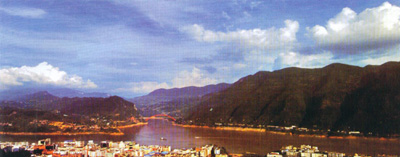SiChuan Tourist Attractions
- Jiuzhaigou Huanglong
- Mount Emei
- Leshan Giant Buddha
- Dujiangyan QingChengshan
- Panda Base
- Sanxingdui Museum
- Wuhou Temple
- Wanjusri Memorial Archway
- ZiGong Salt Industry History Museum
- Du Fu Thatched Cottage
China Tourist Attractions
Sichuan Tours Itineraries
- Chengdu Panda 1-Day Tour
- 2-Days Leshan and Emeishan tour
- 3-Days Huanglong Jiuzhaigou By Air
- Hailuogou 3-Day Private Tour
SanXia Travel
FengDu
Fengdu is located on the northern bank of the Yangtze 176 kilometers downstream from Chongqing Known as the "Ghost City", Fengdu is one of the most popular shore excursion sites for cruise ships of all types sailing along the Yangtze River.
The Ghost City of Fengdu is a collection of Buddhist and Taoist temples set atop a hill known as Ming Mountain and once overlooked the old town of Fengdu, now submerged by the Three Gorges Dam reservoir Fengdu's residents were relocated in 2003 to a new, larger version of Fengdu located across the Yangtze River on the south bank. Where the old town of Fengdu had a population of around 50,000 people, the new relocation city is home to approximately 100,000.Fengdu District is a rich agricultural area that supports approximately 800,000 people living in the surrounding country-side.
Fengdu received its reputation as the"Ghost City" during the Eastern Han Dynasty(25 AD-220 AD). Two officials from the imperial court- Wang Fang Ping and Ying Chang Sheng-were bored with the political life in the court and came to Ming Mountain outside Fengdu City to practice Taoist teachings. Both of them later became immortals by carrying out self-cultivation. When combined together their surnames-Yin and Wang-sound very much like "King of Hell"in Chinese。
Hence the people began to call Fengdu the "Ghost City." This local legend became famous throughout China during the Ming Dynasty about 400 years ago when it was mentioned in the Chinese classic novel, A Journey to the West.

It is important to note that the "King of Hell"in China does not necessarily represent a devil or evil spirit, a comparison to the Greek god Hades is more appropriate To Chinese, the social structure in the Lrnderworld is exactly like that in the real world. In "Hell," spirits would go through a whole bureaucracy of underworld officials to
receive their final judgments. Those pure spirits would be rewarded and those sinful ones would be subject to severe punishments.
Different punishments would be given for different kind of sins The temples built on Ming Mountain display punishing instruments and wild demon images, which vividly depict the Chinese people's imagination of Hell. Landmarks on the hill bear horrible names-Ghost Torturing Pass,Last Glance to Home Tower, No Way Out Bridge,and the River of Blood.
Until the 1950s and 1960s, river boats would often anchor in midstream rather than moor close to Fengdu's banks for fear of ghosts. Ghosts flying out of the underworld and attaching themselves to
the stern of ships was another very real fear for many boat captains.
WuShan
Wushan is situated at the confluence of the Yangtze and Daning rivers just above the western entrance to the Wu (Witches) Gorge.The town has existed for over three thousand years since the late Shang Dynasty(c.1600-1027 BC); Wushan's 30,000 residents were relocated toa new Wushan, located higher up the mountainside after the old town was demolished and submerged in 2003 as a result of the Th ree Gorges Dam reservoir.
The name of the town originates with Wu Xian, a respected Tang Dynasty doctor in the imperial court who is buried on Nanling Mountain on the opposite (south) bank of the Yangtze River. The town of Wushan serves Wushan District, a mountainous region rich in medicinal herbs that encompasses some of
the Three Gorges region's most breathtaking scenic areas: the Daning River valley and half of the Wu Gorge.
Wushan is the starting point for the popular boat trips through the Lesser Gorges on the Daning River and the Mini Gorges on the Madu River. The Daning River winds its way 33 kilometers (20 miles) through the beautiful Lesser Gorges; birds singing and monkeys chattering can be heard and often seen from both banks. The water is a deep, clear shade of grean and forms a striking contrast to the
muddy, turgid waters of the Yangtze.
The first Lesser Gorge is known as Dragon Gata Gorge. In this gorge,the river ranges from only ten to thirty meters wide while the cliffs on either bank soar to an average of 800 to 1000 meters. Mysterious plants and fungus of longevity (lingzhi) are said to grow high up on the cliff face.
Each gorge is separated by lush terracad fields where a variety of crops grow during all four seasons of the year.

In the Misty Gorge, a 2,000 year-old "hanging"coffin can be seen suspended on a precipice high up on the cliff-face. The coffin is a relic left over from the Ba paopla who inhabited the gorges region 3,500 t0 1,800 years ago. At one time hundredsof these coffins could be seen throughoutthe Three
Gorges and the Daning River, suspended from seemingly inaccessible areas on the cliff-sides.
The Emerald Graen Gorge, the farthest from Wushan, is covered with lush bamboo groves and foliage. Midway through the Emerald Green Gorge, passengers can sometimes disembark from their Daning River ferry boats and board motorized sampans to sail through the Mini Gorges of the Madu River.
The Three Gorges Dam Project
The Three Gorges Dam Project is the largest water conservancy project ever built. Operational in 2003 and fully completed in 2009, the massive Three Gorges Dam is located in the middle of the longest of the three Yangtze River gorges, the Xiling Gorge, at a site called Sandouping. The dam is designed to serve three main purposes: flood control, hydroelectric power production, and navigation improvement.
The Three Gorges Dam is 2,335 meters long, 185
meters high, 18 meters wide at the top and 130 meters
wide at the bottom. During the winter months, the
reservoir water level reaches 175 meters above sea
level, approximately 110 meters (363 feet) above the
original river level prior t0 2003. Duringthe summer
months, the reservoirlevel is lowered to 146 meters
above sea levelin orderto regulate and capture flood
water. Throughoul Chinese history, floods along the
Yangtze regularly threatened and brought devastation to
the 15 million people who live in the rich agricultural
region below the dam.

The Three Gorges Dam has created a 600 km (400 miles) long reservoir that stretches from the dam site dam site allthe way to Chongqing and has a storage capacity of39.9 billion cubic meters of water. The creation of this rese rvoir will necessitate the flooding of 570,000 hectares of farmland, thousands of villages and a number of small cities and townships in an area that affects 19 counties and districts. Approximately l.3 million peopla have been relocated to make way for the huge dam.
The cost of this construction project is estimated to amount to Y 230 billion yuan or $ 28 billion US dollars. The construction of the dam formally began in 1994.The dam's 26 generators are designed to generate 18,200 megawatts of electricity annually and open the upper reaches of the Yangtze River to barge fleets of up to 10,000 ton /s, increasing annual shipping from 10 million tons t0 50 million tons.
The Three Gorges Dam project, however, continues
to be enormously controversial as many questions about
the relocation of people, preservation of historical and
archaeological sites, water pollution,accumulation of
silt, and the structure's stability remain.



